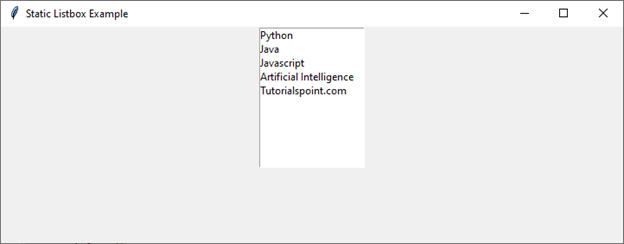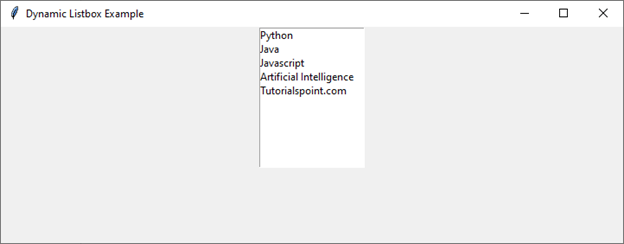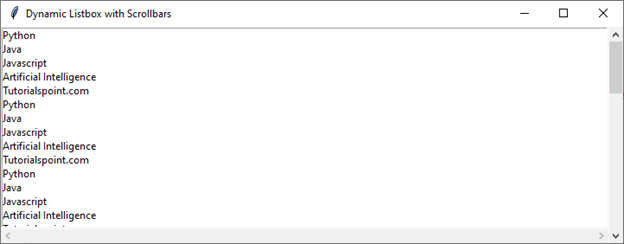
 Data Structure
Data Structure Networking
Networking RDBMS
RDBMS Operating System
Operating System Java
Java MS Excel
MS Excel iOS
iOS HTML
HTML CSS
CSS Android
Android Python
Python C Programming
C Programming C++
C++ C#
C# MongoDB
MongoDB MySQL
MySQL Javascript
Javascript PHP
PHP
- Selected Reading
- UPSC IAS Exams Notes
- Developer's Best Practices
- Questions and Answers
- Effective Resume Writing
- HR Interview Questions
- Computer Glossary
- Who is Who
How to allow Tkinter to generate a listbox from list input?
Tkinter is a powerful library for creating GUIs in Python. One of its essential components is the Listbox widget, which allows users to display a list of items. While it's straightforward to populate a Listbox with static data, dynamically generating it from a list input provides a more flexible and scalable solution. In this tutorial, we will explore how to allow Tkinter to generate a Listbox from list input.
Understanding Tkinter Listbox
Before diving into dynamic Listbox generation, it's crucial to understand the basic structure of a Tkinter Listbox. A Listbox is a widget that displays a list of items in a scrollable box. Each item in the list is assigned an index, starting from 0. You can interact with the Listbox to select and manipulate these items based on their indices.
Static Listbox Population
Let's begin by creating a simple Tkinter application with a static Listbox.
Example
import tkinter as tk
# Create the main Tkinter window
root = tk.Tk()
root.title("Static Listbox Example")
root.geometry("720x250")
# Sample list data
items = ["Python", "Java", "Javascript", "Artificial Intelligence", "Tutorialspoint.com"]
# Creating a Listbox and populating it with static data
listbox = tk.Listbox(root)
for item in items:
listbox.insert(tk.END, item)
# Pack the Listbox to make it visible
listbox.pack()
# Run the Tkinter main loop
root.mainloop()
Output
This code creates a basic Tkinter window with a Listbox containing static items.

Now, let's move on to the dynamic generation of Listbox from list input.
Dynamic Listbox Generation
To generate a Listbox dynamically from a list input, we need to create a reusable function that accepts a list and creates a Listbox accordingly. We'll also include additional features like scrollbars for better navigation.
Example
import tkinter as tk
# Defining the generate_listbox() function
def generate_listbox(root, items):
listbox = tk.Listbox(root)
for item in items:
listbox.insert(tk.END, item)
return listbox
# Defining the main function
def main():
root = tk.Tk()
root.title("Dynamic Listbox Example")
root.geometry("720x250")
# Sample list data
dynamic_items = ["Python", "Java", "Javascript", "Artificial Intelligence", "Tutorialspoint.com"]
# Generating a dynamic Listbox
dynamic_listbox = generate_listbox(root, dynamic_items)
dynamic_listbox.pack()
# Run the Tkinter main loop
root.mainloop()
if __name__ == "__main__":
main()
In this example, the generate_listbox function takes a Tkinter root window and a list of items as parameters. It creates a Listbox, populates it with the given items, and returns the Listbox widget. The main function then uses this function to generate a dynamic Listbox and displays it in the Tkinter window.
Output
Upon running the code, you will get the following output window

Enhancements: Adding Scrollbars
To improve the user experience, especially when dealing with long lists, adding scrollbars to the Listbox is essential. Let's modify our generate_listbox function to include vertical and horizontal scrollbars.
Example
import tkinter as tk
# Defining the generate_listbox() function
def generate_listbox(root, items):
frame = tk.Frame(root)
scrollbar_y = tk.Scrollbar(frame, orient=tk.VERTICAL)
scrollbar_x = tk.Scrollbar(frame, orient=tk.HORIZONTAL)
listbox = tk.Listbox(frame, yscrollcommand=scrollbar_y.set, xscrollcommand=scrollbar_x.set)
for item in items:
listbox.insert(tk.END, item)
scrollbar_y.config(command=listbox.yview)
scrollbar_x.config(command=listbox.xview)
scrollbar_y.pack(side=tk.RIGHT, fill=tk.Y)
scrollbar_x.pack(side=tk.BOTTOM, fill=tk.X)
listbox.pack(side=tk.LEFT, fill=tk.BOTH, expand=True)
return frame
# Defining the main function
def main():
root = tk.Tk()
root.title("Dynamic Listbox with Scrollbars")
root.geometry("720x250")
# Sample list data
dynamic_items = ["Python", "Java", "Javascript", "Artificial Intelligence", "Tutorialspoint.com"] * 10
# Generating a dynamic Listbox with scrollbars
dynamic_listbox = generate_listbox(root, dynamic_items)
dynamic_listbox.pack(fill=tk.BOTH, expand=True)
# Run the Tkinter main loop
root.mainloop()
if __name__ == "__main__":
main()
In this enhanced version, we encapsulate the Listbox and scrollbars in a frame. The yscrollcommand and xscrollcommand parameters are used to link the scrollbars to the Listbox, and the config method is used to establish this connection. The scrollbars are then positioned on the right (for the vertical scrollbar) and at the bottom (for the horizontal scrollbar) of the Listbox.
Output
Upon running the code, you will get the following output window

Conclusion
By introducing a reusable function, we enable the creation of dynamic Listboxes, accommodating changing data requirements seamlessly. Incorporating scrollbars further refines the user experience, particularly when handling extensive lists.

